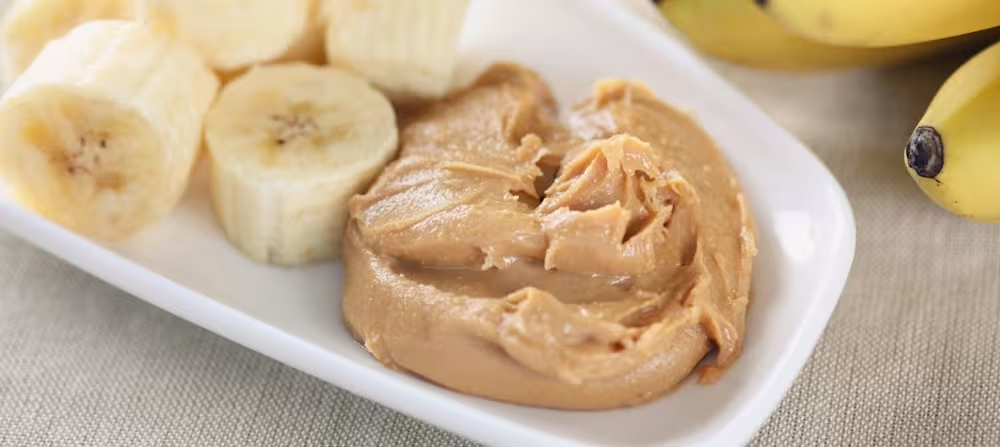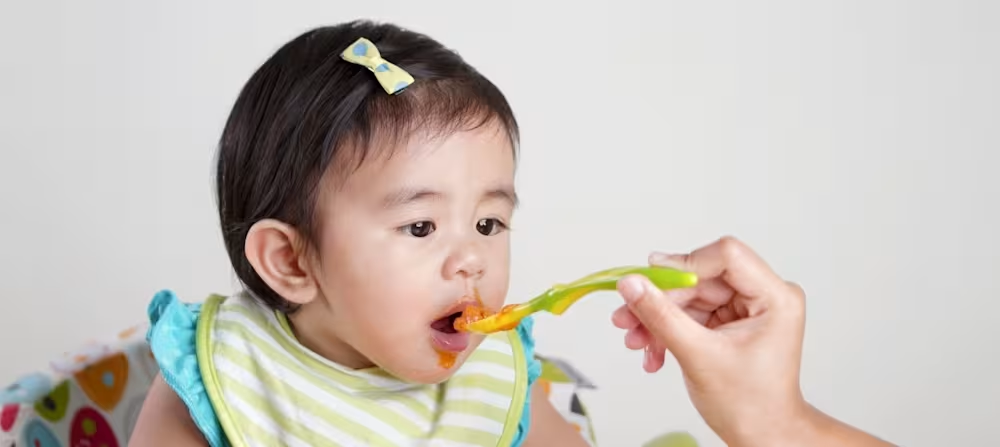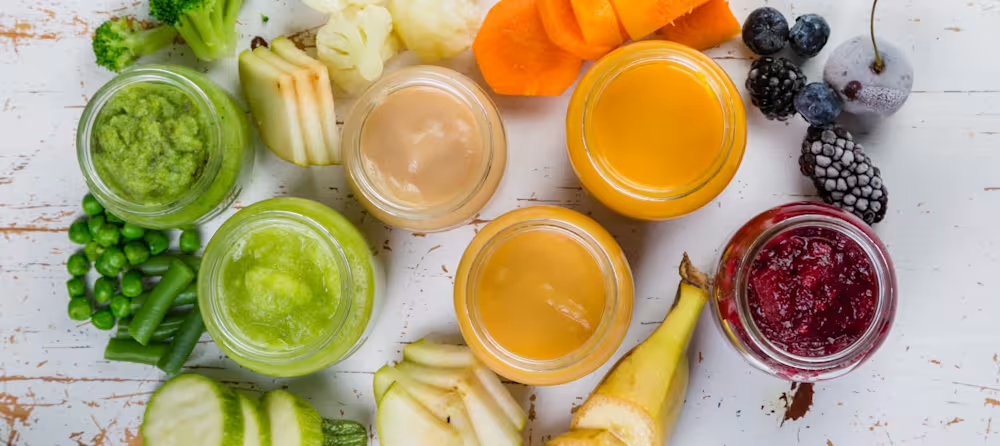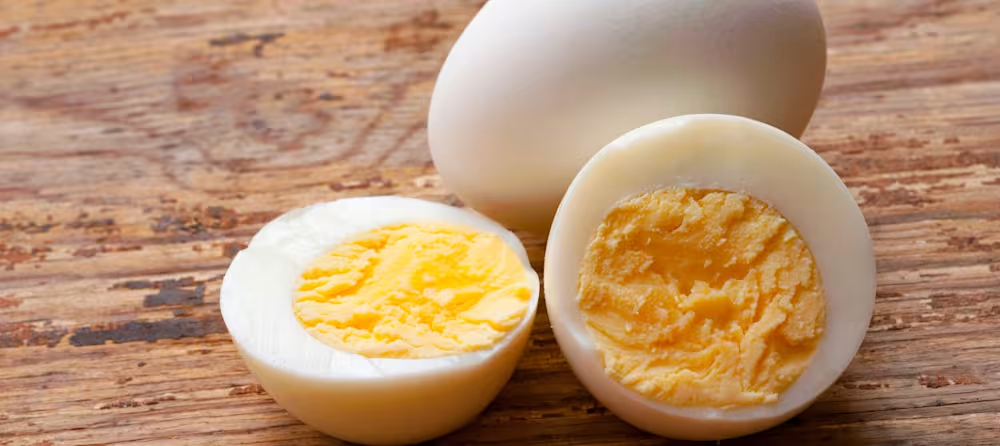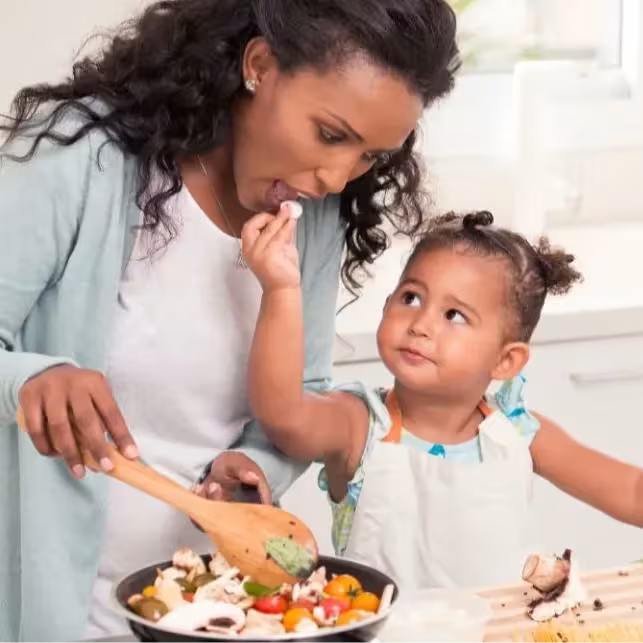Baby-led weaning (BLW): A complete guide to first foods
Updated Oct 02, 2025

Starting solids is an exciting, messy, and sometimes nerve-wracking time for many parents. Using a baby-led weaning approach won’t help with the mess, but it may help relieve parental stress and help babies foster a healthy relationship with food. Keep reading for a step-by-step guide to getting started.
Table of Contents
What is baby-led weaning?
Baby-led weaning (BLW) is one way to introduce solids by focusing on infant self-feeding, and by serving the family’s table foods from the start. The term was popularized by Gill Rapley and Tracey Murkett, co-authors of the in 2009. According to Rapley and Murkett, babies should learn to eat by sitting with family at mealtimes and receive plenty of opportunities to practice feeding on their own.
Some advocates argue are not part of a BLW foods approach, but it’s actually quite common for parents and nutrition and feeding professionals alike to practice a combination of both baby-led and traditional weaning.
The term “weaning” isn’t used to mean a quick transition away from breast milk or formula. All types of baby weaning plans are meant to complement breastmilk or formula intake and to slowly transition your baby to a solid foods diet. Until then, breastmilk and/or formula remain the primary source of nutrition until one year of age, and it’s important not to reduce these feedings once solids are introduced. Babies will naturally reduce their milk or formula feedings on their own as they begin to consume more solid food.
When to start baby-led weaning?
Baby-led weaning (also known as baby-led feeding) should begin at to ensure the baby's digestive and immune systems have enough time to properly develop. Additionally, your baby should show the following signs of readiness before beginning BLW:
Sits up independently with good head and neck control
Loss of tongue thrust reflex
Brings toys or other objects to their mouth
Shows an interest in table foods
Baby food charts for baby-led weaning: BLW foods by age
The charts below represent what a sample day could look like for a baby that age to help you with a weekly meal plan. But remember, you know your baby best and their day may not look exactly like this. Adapt the schedule in a way that works realistically for your family. Family meals are a cornerstone of BLW, so if it is easier to start with dinner instead of breakfast as suggested, do that. Each day might look a bit different and that’s OK too!
Editor's note
If you’re out during the day, mealtime might end up falling close to nap time. If your baby is too sleepy to take interest in eating solids, it may make more sense to offer breastmilk or formula before a nap than to offer solids and make mealtime stressful. Remember, your baby is still getting the nutrition they need from breastmilk and/or formula.
As your child grows, expect to gradually introduce more meals with solids between their regular feedings of breastmilk/formula. We won’t expect babies to get the majority of their nutrition from solids until after their first birthday. That timeline will look something like this:
| Age | Typical solid meal schedule |
|---|---|
| 6 months | 1 solid meal per day |
| 7 - 9 months | 2 solid meals per day |
| 10 - 11 months | 3 solid meals per day |
| 12+ months | 3 solid meals, 2 snacks per day |
How to start baby-led weaning?
Before you begin, make sure to check for signs of readiness (see above). If you have any questions regarding readiness, we recommend checking with your pediatrician before starting solids.
Start slow
Eating is a skill that requires practice and time to master, much like or walking. Start slowly by offering your baby one solid meal a day, ideally as part of family mealtime. Family mealtime can be defined as at least one parent and child eating together. While it sounds involved, family mealtime is just a dedicated moment where you and your baby are eating together.
Choose a meal when your baby isn’t tired or hungry. Note that this may vary from day to day! A helpful way to keep up with this new part of your family’s daily routine is to use the . With sleep and formula/breast milk tracked separately, it can help you identify the windows of time for solids that make the most sense for you.
Set up a safe place to eat
The safest place for a baby to eat is in a highchair. They should be well-supported and able to freely move their arms and hands to reach for food off the tray. Baby’s back should be straight, not reclined. Parents and caregivers should sit facing the baby.
Take your time
Give your baby ample time to explore and play with food in the beginning stages. Do what you can to make mealtimes enjoyable and fun for your baby. Do not try to distract your baby while they are eating.
Choose age-appropriate foods
BLW appeals to many parents because it doesn’t require special baby foods. However, family foods need to be prepared and served in a safe, age-appropriate way. Make sure any baby-led weaning starter foods are served soft and can be easily mashed between two fingers. Start with strips of food, about the size of an adult pinky, and progress to smaller diced foods as your baby’s feeding skills improve.
Offer food without pressure
Baby-led weaning is just that — led by your baby! As a parent, it’s your job to provide baby-led weaning foods and opportunities to practice self-feeding. It is your baby’s job to decide if they will eat and what they will eat. Never put food into your baby’s mouth or try to make them eat more or less than they want.
Learn the difference between gagging and choking
One of the most common concerns parents have when starting solids, no matter the method, is choking — understandably so! The good news is that following safe feeding practices helps to reduce the . Additionally, learning the difference between gagging and choking allows you to respond properly to your baby while feeding.
Gagging is a common occurrence when starting solids and the gag reflex actually works to protect against choking. When gagging, a baby’s airway is not blocked and they are actively working to either swallow or spit out the piece of food. During a true choking event, the airway is blocked and a baby cannot work to dislodge the food themselves. Gagging does not require parent intervention whereas choking does.
| Gagging | Choking |
|---|---|
| Airway is clear | Airway is blocked, or partially blocked |
| Face may turn red, eyes may water | Face and lips may turn blue or purple |
| Sputtering, coughing, and retching noises | Quiet or silent |
| Don't intervene, as you could push food further into their throat | Work to dislodge the blockage |
Introduce one food at a time
The American Academy of Pediatrics recommends introducing your baby to one “single-ingredient” food at a time and waiting three to five days before introducing another food []. This allows you to watch for any food-based reactions. It is worth noting symptoms of food allergies usually occur quickly, within minutes to a few hours.
That said, many feeding experts support early allergen introduction and exposing babies to a wide range of flavors and nutrients early on. For baby-led weaning, choose the approach that feels right for your baby and your family —as long as it’s safe and in line with responsive feeding (being mindful of your child's hunger and fullness cues).
Top 6 benefits of baby-led weaning
May lower the risk of obesity
This approach may reduce the risk of obesity [] later in life due to BLW infants' greater ability to regulate hunger and fullness cues. In fact, studies show toddlers who were weaned using BLW had a lower BMI and incidence of obesity than those who were traditionally spoon-fed. They were also less likely to eat in response to food stimuli, say being offered a snack at a sporting event if they weren’t hungry.
Exposure to a large variety of foods
Although studies aren’t conclusive, there’s reason to believe families who follow a baby-led style will expose their infant to a wider range of foods [] including more textures and flavors than traditional weaning. Consuming a larger variety of foods is associated with better diet quality and health outcomes.
Encourages development of motor skills
Self-feeding is a key component of BLW and provides babies with many opportunities to develop and practice both gross and fine motor skills []. Exploring and picking up foods on their own increases the number of opportunities babies have to practice strength-building movements.
Reduces parental mealtime stress
One study surveyed mothers' attitudes [] about using a BLW approach and found that they reported the approach was simple, convenient, and easy to fit into family lifestyles and mealtimes. They also reported less stress around mealtimes and introducing foods to their infants.
Increases favorable feeding practices
More and more research is examining the role of parental feeding practices on children’s future health outcomes. In general, practicing baby-led weaning may lead to more favorable feeding styles [] such as being less likely to restrict foods or pressuring children to eat. However, it isn’t clear if parents who choose BLW are just less likely to use negative feeding strategies or if BLW encourages the development of favorable feeding practices.
Saves time and money
Parents may save time if they are planning to make their own baby foods by simply serving family foods in a safe way. Additionally, the cost of store-bought baby foods tends to be high, so many families notice savings by not having to purchase these foods.
Are there any risks of baby-led weaning?
Overall, when practiced correctly, baby-led weaning is a safe and effective way to introduce solids to an infant. Research shows no greater risk of choking or nutrient deficiency for this method versus a more traditional weaning style. However, parents should be aware of the following concerns before starting.
Mealtimes get messy
Infants who start consuming solids are going to get messy — there’s really no way around it! Part of learning to eat involves exploring and playing with food as well as sometimes missing their mouth. So if you are the type that can’t handle a mess, it might not be for you.
To make clean-up easier, feed your baby in just a diaper, invest in wipeable bibs, a BPA-free silicone suction bowl, and a washable splash mat for the floor to catch anything that falls. (Dogs are also great at this, but they're much more maintenance.)
Family foods may not always be suitable for infants
One of the best things about this method is that it doesn’t require a lot of extra cooking or food preparation. However, not all family foods may be suitable for infants such as fast food or meals with added sugars or salt [].
These types of foods may negatively impact infants’ immediate health, and may also set them up to prefer these types of foods later in life. While there’s nothing wrong with enjoying these foods in moderation, keep in mind you’ll need to have another option on hand for your baby.
You’ll also want to avoid foods that pose a choking risk (like whole grapes, raw carrots, or chunks of tough meat). Always modify foods to make them safe and age-appropriate before offering them to your baby. Here are some key ways to make foods safe for babies:
Cook foods until they're soft enough to squish between your fingers (e.g. carrots and apples)
Avoid small, round pieces (e.g. grapes, cherry tomatoes)
Cut foods into finger-sized sticks or strips so babies can grip them with their palm
Best baby-led weaning foods
Food category | BLW examples | Foods to avoid |
|---|---|---|
Iron-rich foods | Soft-cooked meat (beef, pork), poultry (chicken, turkey), eggs, beans, lentils, tofu, fortified breakfast cereal | Choking hazards like cubed or round foods (hot dogs), crunchy, hard or crunchy textures |
Protein-rich foods | Soft meat (beef, pork), poultry (chicken, turkey), eggs, beans, cheese, yogurt, nut butter (spread thinly), whole grains | Tough or chewy foods (e.g. steak), high-mercury fish, choking hazards like hot dogs or large chunks |
Fat-rich foods | Avocado, fish, full-fat yogurt, full-fat cheese, olive oil, butter, nut butter, eggs | Whole nuts, hard or crunchy textures |
Fruits and vegetables | Steamed carrots and broccoli, cucumbers, plums (very ripe), kiwi, avocado, banana, berries, watermelon | Raw, hard vegetables that are difficult to chew (carrots); cubed or round foods (grapes, cherry tomatoes) |
Top first foods
While the majority of an infant’s nutritional needs will still be met by breastmilk or formula until about 1 year, complementary foods are still important in boosting an infant’s nutritional intake.
For this reason, it’s recommended that a variety of starter foods be introduced into the diet as early as possible. When setting up a baby-led weaning plan, include foods from all food groups, not just fruits and vegetables, and add in foods rich in high-priority nutrients such as iron, protein, and fats whenever possible.
It’s normal to feel a bit overwhelmed by all the options and the best way to start is just that…by starting and continuing to offer new foods. If you want to keep tabs on which foods you’ve tried, and what reaction baby had to them, you can use the . It’s especially helpful as you get into allergen exposures. (More on that below.)
Iron-rich foods
Iron is responsible for carrying oxygen throughout the body to muscles and organs as well as supporting brain development in young children. Needs are increased early in life due to rapid growth. In order to make sure your baby is getting enough, try to include iron-rich food with every meal if possible.
Meat (beef, pork)
Poultry (chicken, turkey)
Eggs
Beans
Lentils
Tofu
Protein-rich foods
Protein provides the building blocks to support growth and development in babies and young children. Many protein foods are highly nutrient-dense as well, which is important for babies who only eat small amounts of food at a time.
Meat (beef, pork)
Poultry (chicken, turkey)
Fish
Lentils
Tofu
Yogurt
Nut butter
Whole grains
Fat-rich foods
Don’t skimp on the fat! Babies need fat for energy, to help with nutrient absorption and certain fats, such as omega-3 fatty acids, are essential for brain development.
Easily incorporate fat into your baby’s meals by choosing full-fat dairy products, using olive oil or butter to prepare vegetables, or spreading nut butter thinly on toast or crackers.
Fish
Full-fat yogurt
Full-fat cheese
Olive oil
Butter
Nut butter
Eggs
Fruits and vegetables
Fruits and vegetables are full of vitamins and minerals that help promote optimal growth and development. They also provide fiber and early exposure increases the likelihood that babies will continue to enjoy fruits and veggies later on in life.
Carrots (cooked)
Broccoli (cooked)
Butternut Squash (cooked)
Cauliflower (cooked)
Cucumbers
Zucchini (cooked)
Cherry Tomatoes
Sweet potatoes (cooked)
Potatoes (cooked)
Plums (very ripe)
Peaches (very ripe)
Apples (cooked)
Kiwi
Avocado
Banana
Raspberries
Blueberries
Strawberries
Pears (very ripe)
Grapes
Cantaloupe
Watermelon
Cherries (pitted)
Mango (very ripe)
Foods to avoid during baby-led weaning
At times, babies may want to try different foods but be careful to avoid foods that are choke hazards such as:
Raw, hard vegetables that are difficult to chew
Cubed or round foods like grapes or sliced, dime-like hotdogs
Crunchy, hard foods that are heavily textured like chips or popcorn
Honey (not recommended for babies under 12 months, as it can carry infant botulism [])
When to introduce the top food allergens
The latest research on food allergy prevention [] suggests that top allergen foods should be introduced around six months of age when babies start eating solids. You should plan to introduce potential allergens to your baby early on and keep offering them. may occur after the first exposure and beyond. Allergic reactions to food usually occur quickly (within a few hours), but you may consider serving high-risk allergy foods early in the day so you can watch for a reaction. Signs of an allergic reaction often include skin rash, diarrhea, and vomiting.
The following nine foods are currently the : cow’s milk, eggs, wheat, peanuts, tree nuts, fish, shellfish, soy, and sesame. Allergic reactions can range from very mild to very severe. Contact your child’s healthcare provider for guidance if you notice any type of allergic reaction — it’s often better to err on the side of caution when it comes to allergens.
6 month baby-led weaning food chart
At 6 months, we recommend offering baby 1 solid food “meal” per day, however, don’t expect them to consume much. This is practice! Touching, tasting, and spitting out food count as important exposures that will help your little one learn to eat and enjoy food in due time.
Food should be cooked until soft enough to mash between your fingers. It should be cut into strips, about the size of an adult pinky, or mashed and pre-loaded onto a spoon.

7 - 9 month baby-led weaning food chart
At 7 - 9 months, we recommend serving baby 2 solid food meals a day. Food should be cooked until soft enough to mash between your fingers. Food may now be diced into small pieces or mashed and pre-loaded onto a spoon as your little one has likely developed the fine motor skills required to pick up smaller pieces.

If you're curious about developmental milestones around this age, glimpse into what you may experience with the , , and .
10 - 11 month baby-led weaning food chart
At 10 - 11 months, we recommend providing baby with 3 solid food meals a day. Finger foods should be cooked until soft enough to mash between your fingers and cut into small pieces. Children at this age may start using anti-gag utensils (child-sized spoons that feature protective guards to limit baby’s ability to shove the spoon too far into their mouth) more purposefully but don't expect to put the splash mat away just yet.

12+ month baby-led weaning food chart
At 12 months and older, expect your child to eat about 3 solid food meals a day and two snacks. Food should be cooked until soft enough to mash between your fingers and cut into small pieces. At this age, families may choose to introduce or an appropriate milk alternative. Talk to your pediatrician or a pediatric registered dietitian about what’s best for your family.

Takeaway
Baby-led weaning (BLW) is a method of introducing solids by focusing on infant self-feeding and serving family's table foods.
BLW may begin around 6 months, when the baby shows signs of readiness such as sitting up independently, loss of tongue thrust reflex, mouthing toys, and showing interest in table foods.
To start BLW, ensure readiness and begin with one solid meal a day during family mealtime. Use a highchair in a safe setting, allow exploration and play with food, offer age-appropriate portion sizes of soft foods in manageable pieces, and let the baby lead the feeding process.
Top baby-led weaning first foods include iron-rich foods (meat, poultry, beans, lentils, tofu), protein-rich foods (fish, eggs, cheese, yogurt, nut butter), whole grains, fat-rich foods (avocado, yogurt, cheese, nut butter), and various fruits and vegetables.
It's important to adapt a baby-led weaning feeding schedule to the baby's individual needs and consult with a pediatrician or dietitian for guidance.
Baby-led weaning FAQ
Share article:
Note: The content on this site is for informational purposes only and should not replace medical advice from your doctor, pediatrician, or medical professional. If you have questions or concerns, you should contact a medical professional.
10 Sources
Table of Contents
Share article:


